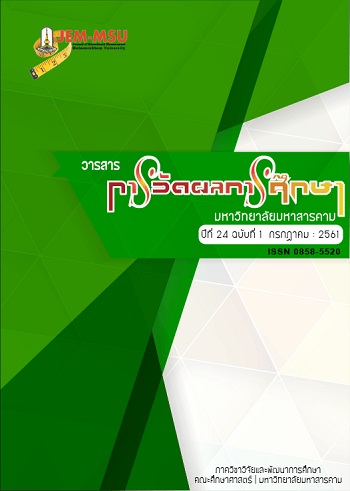A Teacher’s Competency Evaluation Model to Promote 21st Century Learning and Innovation Skills of Lower Secondary Student
Main Article Content
Abstract
This research aims to (1) synthesize competency of teacher to promote the 21st century learning and innovation skills of lower secondary students. (2) develop the teacher’s competency evaluation model to promote the 21st century learning and innovation skills of lower secondary students and (3) examine the quality of the teacher’s competency evaluation model to promote the 21st century learning and innovation skills of lower secondary students. There are 3 stages in this research (1) the synthesis of the teacher’s competency evaluation model to promote the 21st century learning and innovation skills of lower secondary students. (2) the development of the teacher’s competency evaluation model to promote the 21st century learning and innovation skills of lower secondary students and (3) the verification of the teacher’s competency evaluation model to promote the 21st century learning and innovation skills of lower secondary students. Stage 1 of this research was conducted through the involving literature review. Nine experts were also asked to assess and determine the competency of teacher to promote the 21st century learning and innovation skills of lower secondary students. Stage 2 started at collecting data from (1) the 9 experts by using questionnaire of measurement and evaluation guideline. They also evaluate teacher’s competency model (2) the 24 administrators and teachers under the OBEC and local administrative organization. In stage 3, the 72 administrators and teachers under the OBEC and local administrative organization were selected.
The results were as follow:
- The teacher’s competency to promote the 21st learning and innovation skills of lower secondary students were determined into 5 Component, 13 indicators and 52 indicated behaviors. The appropriation assessment of a teacher’s competency by the experts in total at 4.19 by mean and standard deviation was at 0.70
- The model of teacher’s competency evaluation to promote the 21st learning and innovation skills of lower secondary students composts of (1) evaluation target (2) what to evaluate (3) evaluation process (4) Rating, processing, interpreting, and judgment of evaluation result (5) Reporting and using the results. The result of the appropriation assessment of a teacher’s competency evaluation model by the experts in any component was good and higher than the criteria.
3. Qualities of the teacher’s competency evaluation model to promote the 21st learning and innovation skills of lower secondary students were (1) the indicators and criteria of the model using at the small, medium, large school was concurrent validity (2) the rater agreement index (RAI) using the model was at 0.89 (3) the validity of the model in the utility, feasibility, propriety and accuracy from perspective of the administrators and teachers was at high level and at the above the criteria
Article Details
The content and information contained in the published article in the Journal of Educational Measurement Mahasarakham University represent the opinions and responsibilities of the authors directly. The editorial board of the journal is not necessarily in agreement with or responsible for any of the content.
The articles, data, content, images, etc. that have been published in the Journal of Educational Measurement Mahasarakham University are copyrighted by the journal. If any individual or organization wishes to reproduce or perform any actions involving the entirety or any part of the content, they must obtain written permission from the Journal of Educational Measurement Mahasarakham University.
References
2. ขจรศักดิ์ บัวระพันธ์. (2555). “การประเมินทักษะแห่งศตวรรษที่ 21 (ตอนที่ 1)”,จุลสารนวัตกรรม, 7 (26): 4 –9.
3. ไชยยันต์ ถาวระวรณ์. (2544). การพัฒนารูปแบบการประเมินผลการปฏิบัติงานของครูผู้สอนในกรมอาชีวศึกษา. ปริญญานิพนธ์. ครุศาสตร์ดุษฎีบัณฑิต (บริหารอาชีวและเทคนิคศึกษา). บัณฑิตวิทยาลัย มหาวิทยาลัยเทคโนโลยีพระจอมเกล้าพระนครเหนือ.
4. ทรงศักดิ์ ภูสีอ่อน. (2547). การพัฒนารูปแบบการประเมินคุณภาพผู้ประเมินภายนอกสำหรับการศึกษาขั้นพื้นฐาน. ปริญญานิพนธ์. การศึกษาดุษฎีบัณฑิต (วิจัยและประเมินผลการศึกษา). บัณฑิตวิทยาลัย มหาวิทยาลัยนเรศวร.
5. พิชญา ดีมี และเอื้อมพร หลินเจริญ. (2560). การพัฒนาแนวทางการประเมินทักษะการเรียนรู้และนวัตกรรมของผู้เรียนตามแนวคิดการประเมินผู้เรียนในศตวรรษที่ 21. วารสารการวิจัยเพื่อพัฒนาชุมชน (มนุษย์ศาสตร์และสังคมศาสตร์), 10 (2) : 139 – 153.
6. วิจารณ์ พานิช. (2555). วิถีสร้างการเรียนรู้เพื่อศิษย์ในศตวรรษที่ 21.กรุงเทพฯ : มูลนิธิสดศรี-สฤษดิ์วงศ์.
7. ศิริชัย กาญจนวาสี. (2554). ทฤษฎีการประเมิน. พิมพ์ครั้งที่ 8. กรุงเทพฯ : จุฬาลงกรณ์ มหาวิทยาลัย.
8. สถาบันพัฒนาครู คณาจารย์ และบุคลากรทางการศึกษา. (2552).โมเดลสมรรถนะครูและบุคลากรทางการศึกษา. [ออนไลน์]. ได้จาก : http://www.ksp.or.th/upload/278/files/434-2333.pdf. [สืบค้นวันที่ 20 กันยายน 2556].
9. สุรชัย มีชาญ. (2547). ดัชนีความสอดคล้องระหว่างผู้ประเมิน. วารสารสงขลานครินทร์ ฉบับสังคมศาสตร์และมนุษยศาสตร์, 10 (2) : 113-126.
10. สุรศักดิ์ ปาเฮ. (2556). การพัฒนาครูในศตวรรษที่ 21. [ออนไลน์]. ได้จาก : www.addkutec3.com/wp.../การพัฒนาสมรรถนะครูในศตวรรษที่-211.pd... [สืบค้นเมื่อวันที่ 15 กันยายน 2556].
11. สำนักงานคณะกรรมการการศึกษาขั้นพื้นฐาน. (2553). คู่มือประเมินสมรรถนะครู (ฉบับปรับปรุง). กรุงเทพฯ : สำนักงานคณะกรรมการการศึกษาขั้นพื้นฐาน.
12. สำนักงานคณะกรรมการการอุดมศึกษา. (2554). “กรอบแนวคิดการผลิตครูยุคใหม่” .อนุสารอุดมศึกษา. 37 (392): 5-6.
13. APEC HRDWG WIKI. (2012). 21st Century Competencies. [online]. Available From http:// hrd.apect.org/index.php/21st –century –Competencies. [ accessed November 17, 2012]
14. Carolyn, Williams et al. (2006-2008). North Carolina Professional Teaching Standards. North Carolina State Board of Education : North Carolina
15. Eawag. (2008). Sanitation systems & Technologies.. [online]. Available From www.sswm.info/site/default. [ accessed September 20, 2013]
16. Graham Donaldson. (2013). Teaching Profession for the 21st Century : advancing teacher professionalism for inclusive, quality and relevant education. Beograd : Dosije studio.
17. Sanchez, Lori, L. (2007). What makes a good teachers: Are we looking the right direction for guidance. Ph.D. Graduate school of George Fox University, Newberg, United State Code.
18. Seng Dean. (2010, June 21 – 23). Benchmarking Education systems for Results : Asia Regional Conference., 2010. Singapore.
19. Schleicher, A.Ed. (2010). Preparing Teachers and Developing School Leaders for the 21st Century : Lessons from around the word. OECD Publishing.
20. SEAMEO INNOTECH. (2010).Teaching Competency Standards in Southeast Asian Countries : ELEVEN COUNTRY AUDIT. Philippine. [online]. Available From http://www.seameo.org/SEAMEOWeb2/images/stories/Publications/Centers_pub/2012Teaching CompetencyStandards/TeachingCompetencyStd.pdf. [accessed September 20, 2013].
21. UNESCO. (2009). ICT Competency Framework for Teachers UNESCO.org [online]. Available From http://Portal.UNESCO.org/Ci/en/ev.Phi-URL ID=22997&URL DO=DO TopLC & URL SECTION – 201.htm/SZUCS.Eva U. [ accessed September 25, 2013].
22. West Virginia Department of Education. (2011). West Virginia Professional Teaching Standards. Charleston : West Virginia School. [online]. Available From http://wvde.state.wv.us/teachwv/profstandards.html [ accessed September 2, 2013].


